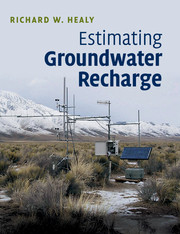Book contents
- Frontmatter
- Contents
- Preface
- Acknowledgments
- 1 Groundwater recharge
- 2 Water-budget methods
- 3 Modeling methods
- 4 Methods based on surface-water data
- 5 Physical methods: unsaturated zone
- 6 Physical methods: saturated zone
- 7 Chemical tracer methods
- 8 Heat tracer methods
- 9 Linking estimation methods to conceptual models of groundwater recharge
- References
- Index
8 - Heat tracer methods
Published online by Cambridge University Press: 05 April 2013
- Frontmatter
- Contents
- Preface
- Acknowledgments
- 1 Groundwater recharge
- 2 Water-budget methods
- 3 Modeling methods
- 4 Methods based on surface-water data
- 5 Physical methods: unsaturated zone
- 6 Physical methods: saturated zone
- 7 Chemical tracer methods
- 8 Heat tracer methods
- 9 Linking estimation methods to conceptual models of groundwater recharge
- References
- Index
Summary
Introduction
The flow of heat in the subsurface is closely linked to the movement of water (Ingebritsen et al., 2006). As such, heat has been used as a tracer in groundwater studies for more than 100 years (Anderson, 2005). As with chemical and isotopic tracers (Chapter 7), spatial or temporal trends in surface and subsurface temperatures can be used to infer rates of water movement. Temperature can be measured accurately, economically, at high frequencies, and without the need to obtain water samples, facts that make heat an attractive tracer. Temperature measurements made over space and time can be used to infer rates of recharge from a stream or other surface water body (Lapham, 1989; Stonestrom and Constantz, 2003); measurements can also be used to estimate rates of steady drainage through depth intervals within thick unsaturated zones (Constantz et al., 2003; Shan and Bodvarsson, 2004). Several thorough reviews of heat as a tracer in hydrologic studies have recently been published (Constantz et al., 2003; Stonestrom and Constantz, 2003; Anderson, 2005; Blasch et al., 2007; Constantz et al., 2008). This chapter summarizes heat-tracer approaches that have been used to estimate recharge.
Some clarification in terminology is presented here to avoid confusion in descriptions of the various approaches that follow. Diffuse recharge is that which occurs more or less uniformly across large areas in response to precipitation, infiltration, and drainage through the unsaturated zone. Estimates of diffuse recharge determined using measured temperatures in the unsaturated zone are referred to as potential recharge because it is possible that not all of the water moving through the unsaturated zone will recharge the aquifer; some may be lost to the atmosphere by evaporation or plant transpiration. Estimated fluxes across confining units in the saturated zone are referred to as interaquifer flow (Chapter 1). Focused recharge is that which occurs directly from a point or line source, such as a stream, on land surface. Focused recharge may vary widely in space and time. If the water table intersects a stream channel, estimates of stream loss are called actual recharge, or just recharge. If the water table lies below the stream channel, estimates are referred to as potential recharge. For simplicity, all vertical water fluxes are referred to as drainage throughout this chapter. Whether the estimated quantity represents actual or potential recharge or drainage depends on the circumstances of each individual study.
- Type
- Chapter
- Information
- Estimating Groundwater Recharge , pp. 166 - 179Publisher: Cambridge University PressPrint publication year: 2010



